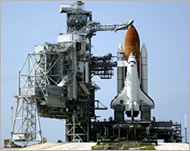Space shuttle set for July 1 lift-off
US space shuttle Discovery is set to launch for the first time in almost a year on July 1, despite continuing safety concerns.

Nasa managers cleared the shuttle for lift-off even though the agency’s top safety officer and its lead engineer objected, officials said on Saturday.
“There were very different viewpoints on the issue of whether we were ready to fly or not,” Michael Griffin, Nasa administrator, told a news conference. “I can’t possibly accept every recommendation given to me by every member of my staff, especially when they all don’t agree.”
The launch will be just the second since space shuttle Columbia disintegrated in 2003 and several officials argued that more modifications to the shuttle’s fuel tank are needed before flights are resumed.
Nasa redesigned the tank after the Columbia accident and then again after the first post-Columbia mission last July. Both times, large pieces of insulating foam fell off the tank.
Columbia was damaged by the falling debris causing it to break up as it flew through the atmosphere on its return to Earth. Seven astronauts died in the accident.
Foam debris
Discovery was not damaged by the foam debris during its launch last July, but Nasa suspended flights while it carried out more modifications. Some engineers say the agency has not gone far enough.
Griffin and other top managers acknowledge the risk of potentially dangerous debris hitting the shuttle and have appointed a special team to redesign the most troublesome areas, known as ice frost ramps.
 |
|
Discovery will be on only its |
The hand-sprayed chunks of foam cover metal brackets on the outside of the tank.
The foam prevents ice, which could break off and strike the shuttle during liftoff, from forming.
Griffin stressed that the crew was not at risk in the forthcoming mission. Since the Columbia accident, Nasa has set up an area for shuttle astronauts aboard the International Space Station should their vehicle become too damaged to safely return to Earth.
Shuttle crews also now inspect their ship for heat shield damage with a sensor-laden boom after they reach orbit.
The shuttle fleet is to be retired in 2010 and sixteen more missions are needed to finish the assembly of the International Space Station before then.